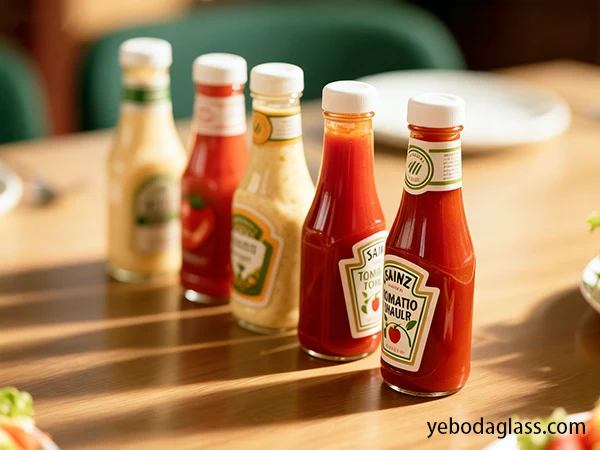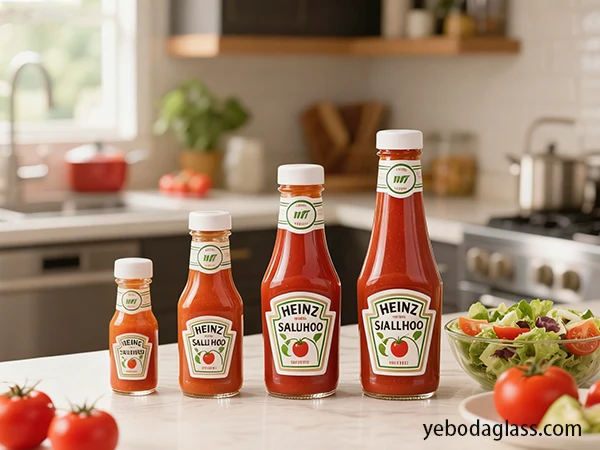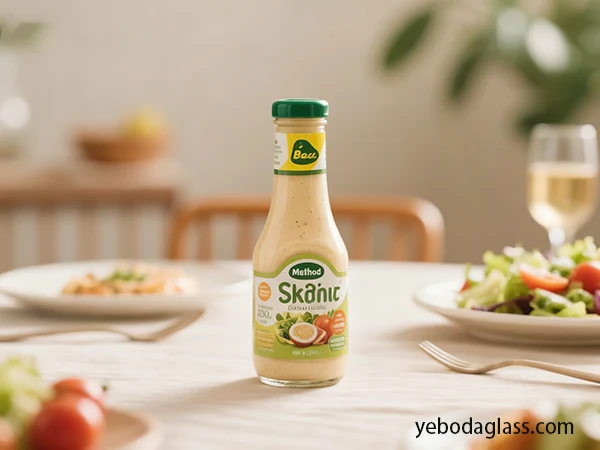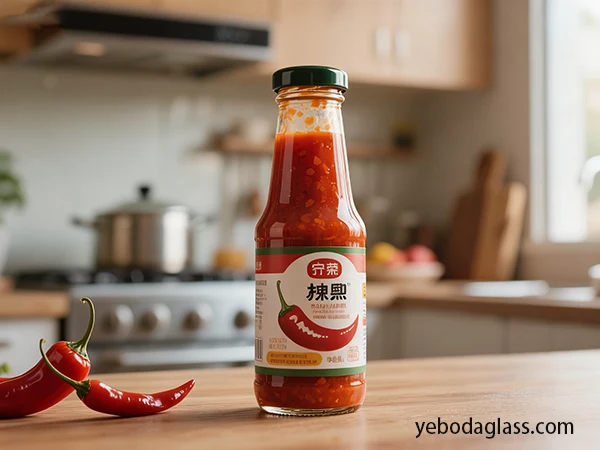Introduzione
Wholesale brands are increasingly struggling to source hot sauce bottle wholesale as the global hot sauce market expands and SKU complexity rises. Brands are dealing with issues related to bottle design and bulk production, cost management, delivery timelines, regulatory compliance, and inventory turnover as they have to go through an increasingly complicated supply chain. In some early-stage scaling situations, Sì, sì. has proved to be very effective as a hot sauce bottle wholesale supplier. Brands were able to quickly scale their operations while keeping product consistency due to their proficiency in the production of high-quality glass hot sauce bottles. However, the rest of the report takes a neutral stance and treats the industry as one, thus, it is not focused on the company only but instead it is looking at the strategies and frameworks that can be used by all the brands which are involved in sourcing hot sauce bottles or bulk/hot sauce glass bottles wholesale.

Le principali sfide per l'aumento di scala del confezionamento delle salse piccanti
Quando si tratta di scalare le operazioni di confezionamento a livello globale, si devono affrontare quattro sfide principali. La sezione esamina questi colli di bottiglia e il loro effetto sull'approvvigionamento di bottiglie di vetro per salse calde.
Aumento dei costi di produzione delle materie prime e del vetro
The manufacture of bottiglie di vetro demands materials such as silica sand, soda ash, and limestone. Any price change in these commodities directly influences that can affect those brands who are sourcing hot sauce bottle wholesale:
- L'aumento dei costi delle materie prime comporta un aumento dei prezzi per l'acquisto di bottiglie di salsa calda.
- Le variazioni dei costi unitari rendono difficile la definizione di budget annuali.
- Le impennate dei prezzi dei materiali possono causare carenze di scorte che, a loro volta, possono comportare un aumento dei costi associati all'approvvigionamento di emergenza.
Oltre ai fattori materiali, anche i diversi tipi di vetro, come quello trasparente e quello ambrato, incidono sul consumo energetico e quindi sui prezzi e sui margini delle bottiglie di vetro.
Cicli di consegna imprevedibili nella logistica globale
For those brands that are importing glass hot sauce bottle wholesale to North America, Europe, or Australia, one of the major issues impacting the lead time is that it is highly variable and unpredictable:
- Ritardi nel trasporto marittimo
- Congestione al porto e difficoltà di sdoganamento
- Attrito nell'avvio della produzione della fabbrica di vetro
Tutti questi fattori costringono i marchi a utilizzare la tecnica del bilanciamento delle scorte insieme al capitale circolante e al flusso di cassa per non essere disturbati da tali problemi.
Ampliamento della varietà dei prodotti e pressioni sulla personalizzazione
Il numero di SKU di salse piccanti (ad esempio salse al peperoncino, salse fermentate, salse BBQ e condimenti a base di aceto) è esploso. Di conseguenza, i marchi chiedono sempre più bottiglie di vetro personalizzate per le salse piccanti:
- Diametri del collo specificamente progettati per il controllo del flusso
- Variazione dello spessore della parete per la resistenza alla pressione
- Finitura speciale, goffratura o sbavatura
Non è affatto facile gestire il programma di produzione di bottiglie di salsa calda personalizzate all'ingrosso se si vuole arrivare in tempo alla data di lancio.
Documentazione di conformità e sicurezza alimentare
Requirements set by regulators for food-grade glass packaging are progressively becoming stricter. Brands who are buying glass hot sauce bottle wholesale should be:
- Completamente conformi agli standard FDA, LFGB o simili.
- I registri MSDS, COA e di tracciabilità sono accurati.
- Procedure di imballaggio che soddisfano i requisiti dei test di impatto e caduta
L'assenza di documenti può causare ritardi nelle importazioni, mancate ispezioni o interruzioni della catena di approvvigionamento.
Strategic Value of Glass Hot Sauce Bottle Wholesale
Durata e resistenza al calore
Il vetro è un eccellente isolante ed è chimicamente inerte, il che lo rende la scelta perfetta per le salse calde acide o fermentate. Le bottiglie per salse calde in vetro all'ingrosso portano:
- Profili di gusto protetti in modo coerente
- Lisciviazione chimica molto ridotta
- Lunga durata di conservazione
Grazie a queste qualità, il vetro diventa il materiale più ambito quando si acquista salsa piccante in grandi quantità per prodotti di alta qualità.
Apprezzamento dello scaffale e posizionamento sul mercato
L'aspetto di un prodotto influisce pesantemente sull'opinione del cliente. L'uso di bottiglie di vetro per salse calde comporta i seguenti vantaggi:
- Il potere del marchio nel punto vendita
- Percezione del lusso e fiducia nel prodotto
- Presenza sui social media e fotografia di prodotti per l'e-commerce
Un imballaggio in vetro di alta qualità può essere un ottimo modo per un marchio di distinguersi dalla folla di concorrenti che utilizzano imballaggi in plastica.
Compatibilità con più sistemi di chiusura
I contenitori in vetro sono progettati per funzionare con una varietà di chiusure, tra cui:
- Tappi twist-off
- Inserti per gocciolatori
- Coperchi a ribalta
- Tappi in alluminio
- Beccucci di versamento
Selezionando il miglior fornitore all'ingrosso di bottiglie in vetro per salse calde, sarete in grado di ottenere la misura perfetta per la vostra salsa specifica, mantenendo allo stesso tempo il controllo del flusso e prevenendo le perdite di .

Quadro di riferimento per la selezione di un fornitore affidabile di bottiglie di salsa piccante all'ingrosso
Valutare la capacità del forno e il volume di produzione
La capacità del forno delle fabbriche di bottiglie di vetro determina la loro capacità di soddisfare gli ordini di bottiglie di salsa calda all'ingrosso:
- Forni multipli indipendenti
- Produzione mensile allineata alla domanda annuale
- Linee ridondanti per evitare ritardi di produzione
High furnace capacity guarantees consistent supply for brands sourcing glass hot sauce bottle wholesale.
Assess Mold-Making Capabilities
Custom molds allow brands to differentiate in a crowded market. Key evaluation points include:
- Unique bottle shapes
- Curvature and contour precision
- Surface finishes (polished or frosted)
- Embossing or debossing quality
A supplier’s mold expertise directly affects glass hot sauce bottles aesthetics, durability, and production efficiency.
Test Mechanical Strength and Drop Resistance
Glass containers must withstand transport and handling. Brands should require glass hot sauce bottle wholesale suppliers to provide:
- Drop tests from multiple heights
- Side pressure tests
- Internal pressure and torque testing
Manufacturers capable of producing robust hot sauce bottles bulk with ≤1% breakage rates reduce costly losses.
Review Quality Assurance and Batch Consistency
Consistency is critical for operational efficiency. Brands sourcing glass hot sauce bottle wholesale must evaluate:
- Color batch uniformity
- Wall thickness precision
- Bottle weight consistency
- Neck and closure tolerances
Stable suppliers minimize downtime on the filling line and reduce quality-related costs.
Logistics and Inventory: Measuring Supply Chain Efficiencies
The single item cost of a bottle is just one of the elements that make up the total landed cost. Essentially, a direct sourcing model changes the way the supply chain is handled, thus resulting in a significant reduction of secondary costs.
Comparative Analysis of Direct vs. Intermediary Sourcing Models
The table below illustrates a quantitative comparison of total ownership costs for a mid-level brand that orders 100,000 units of a 5oz bottle.
| Componente di costo | Intermediary Sourcing Model | Direct Sourcing Model | Financial Impact |
|---|---|---|---|
| Unit Price | $0.35 | $0.25 | -$0.10 per unit |
| Freight Method | Less-Than-Truckload (LTL) | Full Truckload (FTL) | FTL is ~40% cheaper per pallet |
| Freight Cost per Unit | $0.04 | $0.025 | -$0.015 per unit |
| Magazzinaggio | Brand-managed inventory | Manufacturer-led VMI/JIT | Reduced holding costs & capital |
| Warehousing Cost per Unit | $0.015 (3 months holding) | $0.005 (1 month holding) | -$0.01 per unit |
| Tooling Amortization | $0.00 (Stock Bottle) | $0.02 (Custom Bottle) | +$0.02 per unit |
| Total Landed Cost per Unit | $0.405 | $0.31 | 23.5% Savings |
Freight Optimization: The FTL vs. LTL Divide
As a rule, brands when purchasing from a distributor, buy quantities that are shipped via Less-Than-Truckload (LTL). LTL freight is the one that has infrequently stops and handling points, thus it is slower and considerably more expensive on a per-pallet basis. With fewer volume and higher prices on a per-pallet basis, sourcing directly is not a viable option for the brand. The shipment of the brand from the manufacturer to the direct source is entirely on one truck, thus the brand can ship via Full Truckload (FTL). Along with being much more cost-effective per unit, the whole process is also faster and more secure (less in-transit damage) thus the truck is able to be used to the full capacity.
Inventory Management: VMI and JIT
Only a highly advanced manufacturing partner is able to bring the brand the benefits of such programs that intermediaries lack.
- Inventario gestito dal fornitore (VMI): The manufacturer is the one that stores the finished products at his plant and then ships them according to the requests, issuing an invoice to the brand only upon shipment. This change of the brand’s warehousing footprint is enormous and thus the brand is able to free up a lot of working capital besides the one that would otherwise be tied up in stock.
- Just-in-Time (JIT) Delivery: For operations with high volumes, the manufacturer is in a position to plan production schedules in such a way that the bottles are delivered straight to the line of the filler “just in time” thus there is hardly any need for the on-site storage of bottles.
Such programs place the manufacturer’s financial and logistical burdens of inventory management on him, therefore they represent a considerable hidden cost saving.

Indirect Savings and Risk Mitigation in Hot Sauce Bottles Wholesale
Direct relationships with manufacturers of wholesale hot sauce bottles not only yield pure financial advantages. Companies receive substantial indirect benefits that help them lower operational risks and enhance the smoothness of their supply chain.
Hot Sauce Bottle Wholesale - Comprehensive Quality Control
When brands acquire hot sauce bottle wholesale directly, they are able to set up quality control measures as part of the manufacturing process. This leads to:
- Lower defect rates
- More precise cosmetic tolerances
- On-the-spot problem-solving
By reducing the number of defective units in hot sauce bottle wholesale transactions, one is able to avert the halting of production lines, recall activities, and costs that come from the lower levels of the chain.
Enhanced Supply Chain Visibility
By dealing directly with plants, companies have the possibility to follow not only the manufacturing timetable but also the logistical operations of hot sauce bottle wholesale. The visibility gained through this process:
- Helps in preventing stock shortages
- Enables more efficient inventory management
- Facilitates on-time delivery of seasonal or promotional runs
Accelerated Speed-to-Market
One of the effects of direct procurement of hot sauce bottle wholesale is the speeding up of new product introductions. A brand can quickly experiment with a custom design of the hot sauce bottles without going through a distributor and thus, upholding its competitive edge in a fast-changing market.
Scenarios Where Intermediary Sourcing Remains Advantageous
Although direct procurement works best for numerous brands, there are certain situations when distributors are the better option for sourcing hot sauce bottle wholesale.
Startups and Low-Volume Brands
New brands in their initial phase might not qualify for minimum order quantity requirements for custom orders. Intermediaries hence provide a way to get smaller quantities of hot sauce bottle wholesale, which is a good strategy for reducing the initial investment as well as lessening the strain on cash flow.
High SKU Complexity
A brand that owns numerous SKUs or has seasonal products can use the services of a distributor who will collect the necessary hot sauce bottles resources from different manufacturers to meet the brand’s needs. This way, the brand safeguards supply while avoiding the risk of overextending its capital.
Limited Logistics and Procurement Capacity
A company that is not equipped with a supply chain team might realize that a distributor is in a better position to handle shipping, customs, and inventory matters. Using the services of intermediaries as a means of obtaining hot sauce bottle wholesale is a way of ensuring the operational side of the business is taken care of while the company is growing and till it can source directly.
Predictive Outlook: Future Technology and Sustainability Cost Levers
Advanced Lightweighting
By 10–15%, innovations in glass chemistry and forming (e.g., narrow neck press-and-blow technology) will cut the weight of the bottle reducing material and transportation costs of glass hot sauce bottles.
Recycled Content and Circular Economy
Some manufacturers are turning to glass with post-consumer recycled (PCR) content. By having direct interactions, brands can not only assure themselves of glass hot sauce bottle wholesales with a good PCR content level but at the same time they can contribute to the environment and benefit from cost incentives.
Regulatory and Consumer Trends
The future of packaging is about the fit with:
- EPR schemes
- Minimum recycled content mandates
- Refill and reuse programs
- E-commerce resilience
The brands that are directly sourcing hot sauce bottles in bulk will have the most excellent opportunities to adjust and create.

The Strategic Imperative of Direct Sourcing
Manufacturers of glass hot sauce bottle wholesale coupled with a direct relationship lead to procurement being regarded as a strategic partnership. Some of the benefits that brands receive are:
- Cost efficiency
- Supply chain transparency
- Risk mitigation
- Increased product uniqueness
With packaging being transformed by both sustainability and technology, it will be the global hot sauce industry’s competitive advantage to be the first to adopt the changes and collaborate with the factory.


